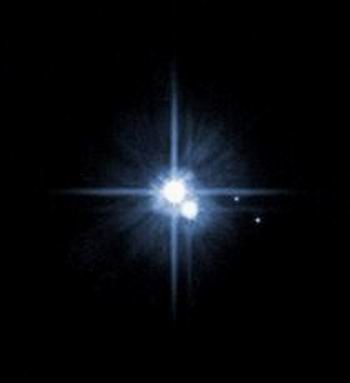
|
|

|
|
| April 26, 2024 |
|
Another Earth may be 500 light years away 
Some 500 light-years away, a little planet basks comfortably in the heat of its sun. It's probably rocky – as the Earth is – and it's probably just the right temperature to boast liquid water. In other words, it's about as close to Earth as any planet we know of.
Unveiled at a recent meeting of the American Astronomical Society, the planet Kepler-438b may be the Earth twin that researchers have long sought. Other planets have made claims to that title, but Kepler-438b is more similar to Earth in both size and in the amount of energy it receives from its star than a celebrated runner-up, several scientists said. That runner-up, planet Kepler-186f, might be called "a cousin of Earth," the University of Puerto Rico's Abel Mendez, keeper of a database of planets outside our solar system, said via email. But 438b and another recently discovered planet are "brother and sister-in-law. We are getting closer." Kepler-438b and compatriot planet Kepler-442 b "are the best candidates we have so far for Earth analogues," said astronomer Willy Torres of the Harvard-Smithsonian Center for Astrophysics, a co-author of a paper in The Astrophysical Journal describing the new planets. Both were found with the help of NASA's Kepler spacecraft, which launched into space in 2009. Kepler 438-b is only 12 percent bigger in diameter than Earth, unlike the large number of "super-Earths" scientists have turned up outside our solar system. It has a 70 percent chance of being rocky, which scientists regard as a requirement for supporting life. And its surface receives roughly 40 percent more energy from its small star than Earth's surface receives from the sun. Kepler-438b "could be a perfect twin of Earth. We just don't know, because we can't pin down the measurements," Torres said. Kepler 442-b, on the other hand, is definitely bigger than Earth and receives substantially less energy from its star, knocking it out of the running for Earth twin. Sadly, Kepler-438b may represent something of an astronomical dead end. It is so far away, and its star so dim, that finding out whether it bears life or even an atmosphere is a daunting challenge, if not impossible. "Discoveries of worlds like Kepler-438b are simultaneously satisfying and tantalizing," planet-hunter Gregory Laughlin of the University of California, Santa Cruz, said via email. "It's extremely exciting to know that planets with potentially Earth-like conditions are out there, but learning what they actually are like will require a great deal of fortitude, creativity and hard work." Scientists also announced at the astronomy meeting that they'd found eight new candidate planets – planets that haven't been 100 percent verified -- in the so-called "Goldilocks zone," where their surfaces are neither too hot nor too cold to sustain liquid water. Unlike previously discovered planets outside the solar system, these candidates orbit stars much like our own sun. For example, the candidate planet KOI 5737.01 – "romantically named," joked Fergal Mullally of NASA's Ames Research Center -- takes roughly 365 days to travel around its sun-like star, just as the Earth does, and preliminary estimates peg it as only a third bigger than Earth. Similarly, the candidate planet KOI 2194.03 is 40 percent larger than Earth. "These candidates represent the closest analogues to the Earth-sun system to date," said Mullally, "and this is what Kepler has been looking for." These new Earth-sized candidate planets in the water-friendly zone of their stars "are super-exciting," said Lehigh University astronomer Joshua Pepper. "And those numbers are only going to increase as time goes on. … We're only going to find more and more of these." (Source: USA Today) Story Date: January 26, 2015
|